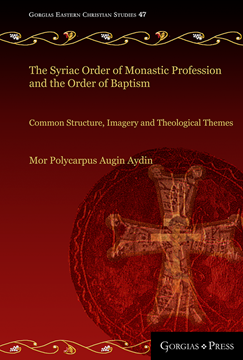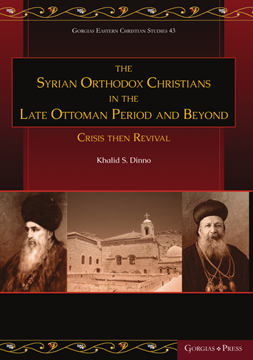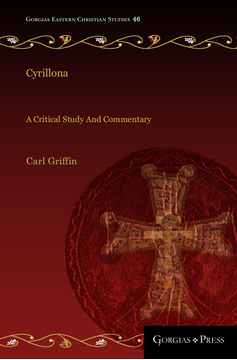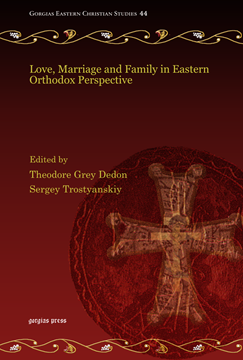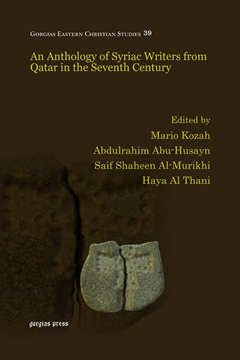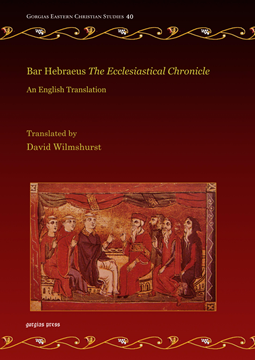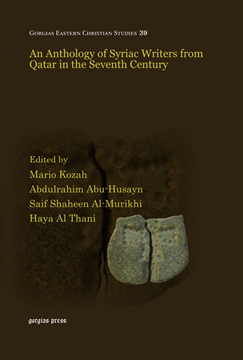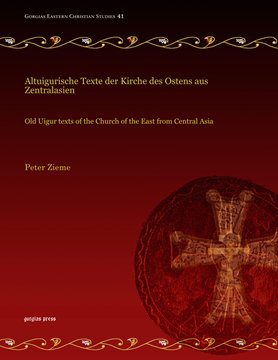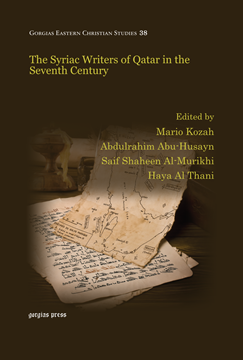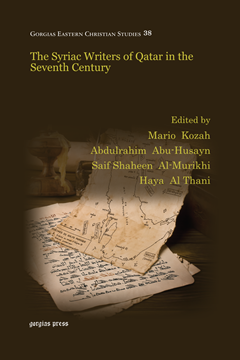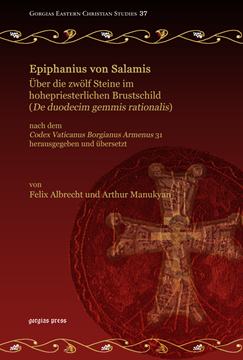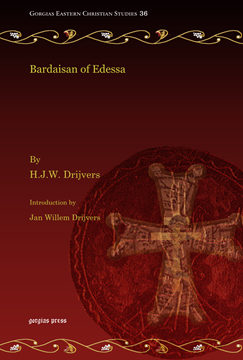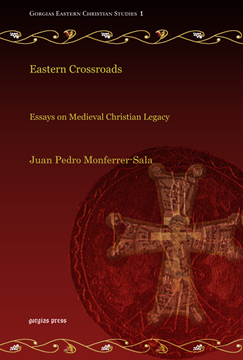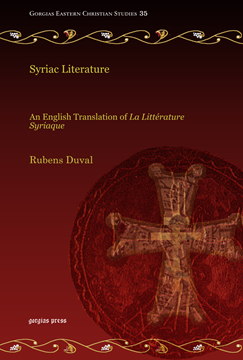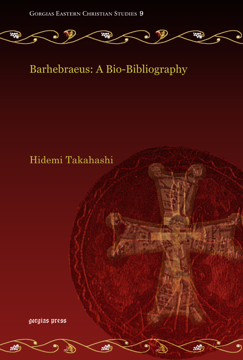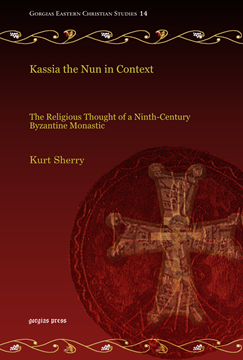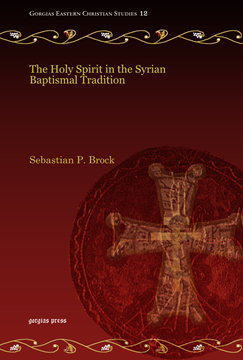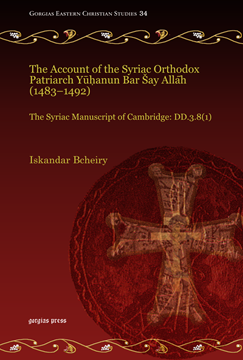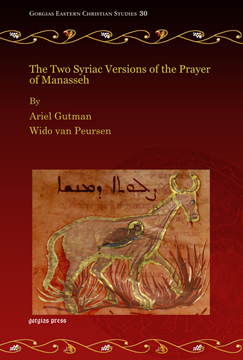Gorgias Eastern Christian Studies
Gorgias Eastern Christian Studies brings to the scholarly world the underrepresented field of Eastern Christianity. This series consists of monographs, edited collections, texts and translations of the documents of Eastern Christianity, as well as studies of topics relevant to the world of historic Orthodoxy and early Christianity.
The Syriac Order of Monastic Profession and the Order of Baptism
Common Structure, Imagery and Theological Themes
Series: Gorgias Eastern Christian Studies 47
ISBN: 978-1-4632-0619-2
Is monastic profession in the West-Syriac tradition a “second baptism”? A relationship clearly exists between the two rites of initiation in the West-Syriac tradition: the monastic profession and baptism. Aydin examines these two rites of initiation, comparing their external structures, common imagery and theological themes, and reveals that the monastic rite closely parallels, or even is modeled upon, that of baptism. Mor Polycarpus Edip Aydin explores the idea of monastic profession as a “second baptism,” or rather, the realization of what the gift of the Spirit at baptism really implies. An extensive Appendix contains Syriac texts with English translations pertaining to the Syriac rite of monastic profession, with relevant commentaries by Syriac Fathers from the 6th to the 10th centuries.
$128.00 (USD)
The Syriac Tradition of the Infancy Gospel of Thomas
A Critical Edition and English Translation
By Tony Burke
Series: Gorgias Eastern Christian Studies 48
ISBN: 978-1-4632-0584-3
A long-awaited and essential tool for the study of one of the earliest texts of the Christian Apocrypha and an important text in Syriac literature, theology, and history.
$168.00 (USD) $134.40 (USD)
The Syrian Orthodox Christians in the Late Ottoman Period and Beyond
Crisis then Revival
Series: Gorgias Eastern Christian Studies 43
ISBN: 978-1-4632-0575-1
The book addresses the history of Syrian Orthodoxy during a critical juncture of its history that spans the late Ottoman period and treads well beyond to witness remarkable revival, indeed renaissance. The work uniquely utilizes over 6000 uncatalogued and unpublished archival documents that were made available for it.
$85.00 (USD)
Cyrillona
A Critical Study and Commentary
By Carl Griffin
Series: Gorgias Eastern Christian Studies 46
ISBN: 978-1-4632-0607-9
Cyrillona (fl. 396) was a younger contemporary of Ephrem the Syrian whose work has been celebrated as comparable in both beauty and its significance for our understanding of early Syriac Christianity. This study reassesses conventional claims about the author’s identity, date, and the constitution of his corpus. It introduces each of Cyrillona’s five surviving poems and examines their poetic form and genre, structure and rhetorical features, and critical questions of text, interpretation, and theology.
$169.00 (USD)
Love, Marriage and Family in Eastern Orthodox Perspective
Edited by Theodore Grey Dedon & Sergey Trostyanskiy
Series: Gorgias Eastern Christian Studies 44
ISBN: 978-1-4632-0596-6
This volume offers an array of theological and sociological studies on Family, Love, and Marriage in the Eastern Orthodox tradition. As new ways of understanding these institutions and concepts emerge in a modern society, this compilation sponsored by the Sophia Institute of Eastern Orthodox Studies incorporates a revisiting of biblical and Patristic understandings as they are received in the wider Orthodox Christian perspective.
$167.00 (USD)
An Anthology of Syriac Writers from Qatar in the Seventh Century
Series: Gorgias Eastern Christian Studies 39
ISBN: 978-1-4632-0545-4
The Syriac writers of Qatar have not received the scholarly attention that they deserve in the last half century. This anthology seeks to redress such an underdevelopment by providing new material in English translation with accompanying Syriac and Garshuni editions to encourage further research in the sub-field of Beth Qatraye studies. It includes the work of some of the most prominent scholars in this field.
$25.00 (USD)
Icons of the Heavenly Merchant
Ephrem and Pseudo-Ephrem in the Madrashe in Praise of Abraham of Qidun
By Andrew Hayes
Series: Gorgias Eastern Christian Studies 45
ISBN: 978-1-4632-0414-3
A detailed study of a cycle of fourth-century liturgical poems, in Syriac, dedicated to a great pioneer of the Syriac ascetical tradition. Hayes analyzes its various portraits of the saint, shaded differently by Ephrem and his later imitators.
$187.00 (USD)
Bar Hebraeus The Ecclesiastical Chronicle
An English Translation
Translated by David Wilmshurst
Series: Gorgias Eastern Christian Studies 40
ISBN: 978-1-4632-0535-5
The Ecclesiastical History of Bar Hebraeus is an important source for the history of the Syrian Orthodox Church and the Church of the East. It deserves to be widely read, but has never before been fully translated into English. David Wilmshurst, a noted historian of the Church of the East, has now provided a graceful and accurate English translation of the Ecclesiastical History, with the aim of winning this important text the readership it deserves. Wilmshurst's elegant translation is complemented by a well-informed and helpful introduction, several pages of maps and a comprehensive index of places and persons.
$229.00 (USD)
An Anthology of Syriac Writers from Qatar in the Seventh Century
Series: Gorgias Eastern Christian Studies 39
ISBN: 978-1-4632-0547-8
The Syriac writers of Qatar have not received the scholarly attention that they deserve in the last half century. This anthology seeks to redress such an underdevelopment by providing new material in English translation with accompanying Syriac and Garshuni editions to encourage further research in the sub-field of Beth Qatraye studies. It includes the work of some of the most prominent scholars in this field.
$110.00 (USD)
Altuigurische Texte der Kirche des Ostens aus Zentralasien
Old Uigur texts of the Church of the East from Central Asia
By Peter Zieme
Series: Gorgias Eastern Christian Studies 41
ISBN: 978-1-4632-0551-5
The book presents a full documentation of the Old Uigur texts of the Church of the East known from several places of Central Asia, mainly Bulayık and Kurutka in the Turfan oasis, as well as Xaraxoto, from the 10th to 14th century.
$164.00 (USD)
Orthodox Monasticism Past and Present
Edited by John A. McGuckin
Series: Gorgias Eastern Christian Studies 42
ISBN: 978-1-4632-0530-0
Studies in Eastern Orthodox monastic life and culture. Part 1 is devoted to New Testament, Patristic, and Byzantine foundations of eastern monastic theory, and Part 2 is comprised of contemporary reflections on Orthodox monastic life.
$230.00 (USD)
The Syriac Writers of Qatar in the Seventh Century
Series: Gorgias Eastern Christian Studies 38
ISBN: 978-1-4632-0524-9
The Syriac writers of Qatar themselves produced some of the best and most sophisticated writing to be found in all Syriac literature of the seventh century, but they have not received the scholarly attention that they deserve in the last half century. This volume seeks to redress this underdevelopment by setting the standard for further research in the sub-field of Beth Qatraye studies.
$157.00 (USD)
The Syriac Writers of Qatar in the Seventh Century
Series: Gorgias Eastern Christian Studies 38
ISBN: 978-1-4632-0355-9
The Syriac writers of Qatar themselves produced some of the best and most sophisticated writing to be found in all Syriac literature of the seventh century, but they have not received the scholarly attention that they deserve in the last half century. This volume seeks to redress this underdevelopment by setting the standard for further research in the sub-field of Beth Qatraye studies.
$25.00 (USD)
The Life and Works of Severus of Antioch in the Coptic and Copto-Arabic Tradition
Texts and Commentaries
Series: Gorgias Eastern Christian Studies 28
ISBN: 978-1-61719-738-3
Severus of Antioch is by far the most prolific and well known theologian of the non-Chalcedonian churches. Although his life and writings came to our knowledge in Syriac, gaining him the title “Crown of the Syriac Literature,” many texts relating to his life and works survived in the Coptic and Copto-Arabic tradition, as well as a number of other texts that were traditionally attributed to him. This book provides an analysis of these texts as well as a discussion of the veneration of Severus of Antioch in the Coptic Church.
$223.00 (USD)
Epiphanius von Salamis, Über die zwölf Steine im hohepriesterlichen Brustschild (De duodecim gemmis
nach dem Codex Vaticanus Borgianus Armenus 31 herausgegeben und übersetzt
Series: Gorgias Eastern Christian Studies 37
ISBN: 978-1-4632-0279-8
At the request of Diodorus, bishop of Tyre, Epiphanius of Salamis produced this exegetical treatise on the gemstones in the High Priest's breastplate. The oldest Christian work on gemstones, the the author deals with the stones according to their appearance and their medical benefit as well as their attribution to the twelve tribes based on Christian exegesis. Only extracts of this work are preserved in Greek. This volume provides the important – but hereto unconsidered – Armenian text with a German translation and commentarial annotations, as well as an English introduction.
$120.00 (USD)
Bardaisan of Edessa
Introduction by Jan Willem Drijvers; By H.J.W. Drijvers
Series: Gorgias Eastern Christian Studies 36
ISBN: 978-1-4632-0188-3
In this volume, a reprint of his 1966 monograph, H. J. W. Drijvers investigates the life and teachings of Bardaisan of Edessa, determining his place in the religious and cultural life of Edessa in the second half of the second century of the common era.
$163.00 (USD)
Eastern Crossroads
Essays on Medieval Christian Legacy
Series: Gorgias Eastern Christian Studies 1
ISBN: 978-1-59333-610-3
This volume contains papers from the First International Congress on Eastern Christianity held in Córdoba, Spain, November 2005. The encounter of medieval Christian writers with several linguistic traditions through the Middle Ages produced one of the most important branches of Middle Eastern literature. This encounter not only changed the nature of the respective writings throughout time, but also influenced considerably the development of the legacies transmitted by the writers and the scholars of various Eastern Christian churches.
$214.00 (USD)
Syriac Literature
An English Translation of La Littérature Syriaque
By Rubens Duval
Series: Gorgias Eastern Christian Studies 35
ISBN: 978-1-61143-962-5
Despite having been written over a century ago, the 3rd edition of Rubens Duval's History of Syriac Literature remains one of the best - and most readable - introductions to Syriac literature. This edition provides the first English translation of the work, translated by Olivier Holmey.
$179.00 (USD)
Barhebraeus
A Bio-Bibliography
Series: Gorgias Eastern Christian Studies 9
ISBN: 978-1-59333-148-1
An extensive account of the life and works of Barhebraeus based on the latest research. It includes an appendix containing a comprehensive list of bibliographical references and manuscripts relating to Barhebraeus.
$231.00 (USD)
Kassia the Nun in Context
The Religious Thought of a Ninth-Century Byzantine Monastic
By Kurt Sherry
Series: Gorgias Eastern Christian Studies 14
ISBN: 978-1-61143-969-4
Kassia the Nun offers a unique glimpse into ninth-century Byzantium in the only woman whose works were included in the corpus of liturgical hymns. This volume explores Kassia’s thought on Christology, on gender, and on monasticism itself. It provides readers with an opportunity to know this woman of remarkable intellect, wit, and piety by drawing primarily on her own words. Kassia’s is one of the only female voices from ninth-century Byzantium and this volume accordingly examines her reflections on gender in the context of her society and concludes that she represents a perspective that might be described as feminist.
$123.00 (USD)
The Holy Spirit in the Syrian Baptismal Tradition
Series: Gorgias Eastern Christian Studies 12
ISBN: 978-1-59333-844-2
A sensitive and evocative treatment of the role of the Holy Spirit in worship. With a keen awareness of the tradition of Syrian Christianity, Brock begins his exploration with the role of the Holy Spirit in the Syriac Bible. A striking aspect of this tradition is the imagery used for the Spirit, including: compassionate mother, fire, olive oil, as well as the more common image of dove. Brock also summarizes commentaries and other literature on the baptismal rite, touching on Syriac literature and works translated from the Greek.
$137.00 (USD)
The Account of the Syriac Orthodox Patriarch Yūḥanun Bar Šay Allāh (1483–1492)
The Syriac Manuscript of Cambridge: DD.3.8(1)
Series: Gorgias Eastern Christian Studies 34
ISBN: 978-1-4632-0213-2
This volume provides an analysis of a late fifteenth century document, a hitherto unpublished narration of the life and accomplishments of Yūḥanun Bar Šay Allāh, a fifteenth-century Syriac Orthodox Patriarch. It includes considerable unique historical information, shedding light on the history of the Syriac community in relation to other communities. It also supplies descriptions of events that brought important changes to the Syriac Church in Mesopotamia, Syria and Egypt.
$106.00 (USD)
A 16th Century Italo-Byzantine Cross
Edited by Sheila Campbell
Series: Gorgias Eastern Christian Studies 32
ISBN: 978-1-4632-0163-0
The contributors have tried to reconstruct the mingling of two cultures, Greek and Italian, in sixteenth century Venice. This is examined through the medium of a single intricately carved wooden cross, executed by a Greek carver, with adaptations suitable to a member of the Latin church. We can identify the carver who made the cross and make some speculations about his life, and how he and his art are reflective of this hybrid culture. This type of cross seems to be for personal, rather than liturgical use, and it seems to be intended for private meditation on the Passion.
$165.00 (USD)
Vie de S. Macaire l’Egyptien
Edition et traduction des textes copte et syriaque
By Satoshi Toda
Series: Gorgias Eastern Christian Studies 31
ISBN: 978-1-61143-971-7
Saint Macarius the Egyptian’s (c. 300–390) virtue and spiritual exploits gave rise to various tales and sayings. These were recounted, some hundred years later, in hagiographical form, and were then disseminated in various languages of the Christian Orient, including Coptic, Syriac, Arabic, Ethiopic, Greek, and Georgian. This book presents a rare study of a text, taking into account its transmission in multiple languages, accompanied by newly re-edited Coptic and Syriac versions of the Life. This book also provides a commentary on the life of the “historical Macarius”, as well as the Life seen as a literary, hagiographical, work.
$270.00 (USD)
The Two Syriac Versions of the Prayer of Manasseh
Series: Gorgias Eastern Christian Studies 30
ISBN: 978-1-4632-0050-3
The authors present a detailed philological and linguistic comparison of two versions of The Prayer of Manasseh. Combing state-of-the-art computational tools together with traditional philology, the texts are compared at all linguistic levels, from their vocabulary up to their discursive structure, with a special emphasis on their morphology and syntax. The results are revealing not only for the question of the relationship between the two versions, but they also illuminate various debates pertaining to Syriac syntax.
$184.00 (USD)

